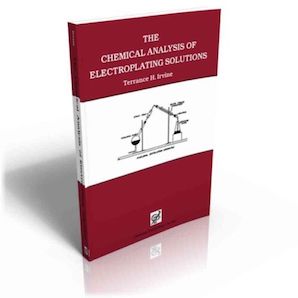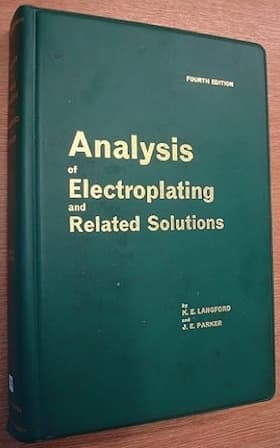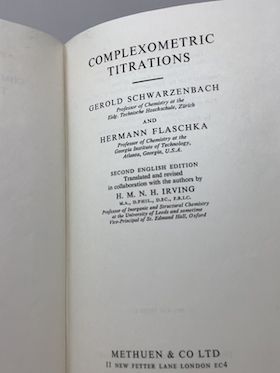
-----
Procedure for Titration of ferric chloride ?
Q. Does anyone know a specific test method for titrating a ferric chloride ⇦ on eBay or Amazon [affil link] etch solution, (i.e., what is the oz/gal of FeCl3)? The tank has been made up of 45 oz/gallon FeCl3, and 12% by volume HCl. I have a test method for ferrous chloride and total iron, but not ferric chloride ⇦ on eBay or Amazon [affil link] .
by Terrance H Irvine

on eBay or Amazon
or AbeBooks
(affil link)
Gear Manufacturer - Park City, Utah
2003
A. Didn't you answer your own question? You can measure ferrous and you can measure total Fe. Well, the difference is ferric.

Jon Barrows, MSF, EHSSC
Kansas City
by Langford & Parker

on Amazon
or AbeBooks
(affil link)
Q. Dear Sir,
we utilise such a solution with Hydrochloric Acid at 100-120 g/litre and ferric chloride
⇦ on
eBay or
Amazon [affil link] Hexahydrate at 400-500g/litre concentration.
To analyse for ferric chloride
⇦ on
eBay or
Amazon [affil link] potentiometrically, I take a 0.5ml sample of process solution, dilute to 100 mls with de-ionised water and add 5 gms of Potassium Iodide together with a small bar magnet to stir the solution then run the sample on the auto-titrator with 0.1N sodium thiosulphate
⇦ on
eBay
or
Amazon [affil link]
solution. The end-point comes at approximately 17 mls of Sodium Thiosulphate (usually about 250mV)
If you have such equipment at your disposal I would give it a try!
Good luck
- Blantyre, South Lanarkshire, Glasgow
2003
?. Where did you get your method for Ferrous Chloride?
Scott Graytesting - Latrobe Pennsylvania
December 3, 2009
Q. I saw some posts from 4 years ago on this subject but was wondering what the thinking is now. I need to know how to analyze for ferric chloride and hydrochloric acid % in our etchant. I'm looking for a simple titration if possible. The workers do a baumé everyday and check that. The problem is that they use the ferric for a certain number of boards and then change the solution. But if they run several thicker boards the ferric wears out sooner and they don't realize it until it gets rejected at QC and has to be remade. They would like to have the solution analyzed on a daily basis to check for depletion. Any help is greatly appreciated.
Barb MyersPlating shop - Colorado Springs, Colorado, USA
2005
A. Without knowing the composition of the solution you are analyzing, it is impossible to give a precise method. It is possible to measure Fe(III) with standard EDTA (Nitric acid interferes). You would adjust the pH of the sample solution with glycine, warm it and employ 5-Sulfosalicylic acid as the indicator. The color change is from red to pure yellow.
Determining the acid content may be a little more complicated. If there are no interferents, you should be able to do a total acidity titration using a standard base and phenolphthalein
⇦ on
eBay &
Amazon [affil link]
indicator. Correct for the Fe(III) (1 mole = 3 moles acid) to find the HCl. I suggest you find the text by Schwarzenbach and Flaska for more information. I think the title is "Compexiometric Titrations" ⇨
- Cleveland Heights, Ohio
A. A method that maybe can work for you :
First analyze iron. If you have nitric acid do this :
1- Pipet 1 mL to an erlenmeyer, add 10 mL d.i. water
2- Heat to dryness on an hot plate
3- Let cool a bit and add 5 mL concentrated HCl to dissolve
solid and add 30 mL d.i. water
4- add some KI and titrate liberated iodine with
1N sodium thiosulphate
⇦ on
eBay
or
Amazon [affil link]
with starch just before the end
point
1 mL Na2S2O3 1N = 0.05585 g Fe
For chloride, you can determine it by precipitation with
silver nitrate
⇦ on
eBay or
Amazon [affil link]
. Substract chloride linked to iron (3:1)
I'm wondering too if Mohr's method do the job as :
1- 1 mL sol'n + 50 mL d.i. water
2- neutralize with ammonium hydroxide
3- 1 mL indicator (4.2% K2CrO4 + 0.7% K2Cr2O7 in d.i.water)
4- Titrate with silver nitrate 1N to red-brown end point.
Subtract chloride linked to iron (3:1)
- Bromont, QC, Canada
Q. Hi
Can you please help me.
I need to find out how to test the Fe- Content and the HCI content in the acid pickling bath of our galvanizing plant.
Quality Controller - Steelpoort, Limpopo, South Africa
May 11, 2011
Readers may also be interested in these related threads:
• Topic #106/43 "Analyze acid level (HCl) in ferric chloride solution"
• Topic #429/58 "Looking for a titration method for ferric chloride"
Q, A, or Comment on THIS thread -or- Start a NEW Thread
 on eBay
on eBay